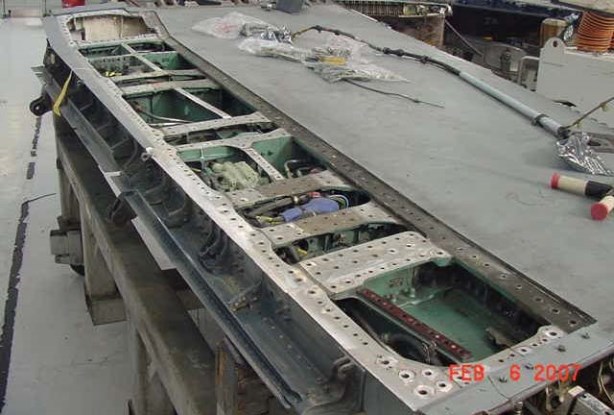To help engineers and designers make good design and maintenance material choices by predicting and quantifying galvanic corrosion risk at material interfaces, an easy-to-use software program was developed by Corrdesa, LLC (Newman, Georgia) for the Sea-Based Aviation team under a Small Business Innovation Research contract from the Office of Naval Research (ONR) (Arlington, Virginia). The software, available online and as an app for iOS and Android platforms, calculates the galvanic corrosion current and corrosion rate using an electrochemical database comprised of qualified polarization curves for various materials. The software innovation, Corrosion Djinn™—Galvanic Corrosion Risk Prediction, is a recipient of a 2017 MP Corrosion Innovation of the Year Award.
 Galvanic corrosion between dissimilar materials is a primary cause of structural failure that puts aircraft and other equipment out of service. Because so many disparate materials are used, galvanic corrosion is the most serious corrosion mechanism in aircraft (Naval aircraft in particular). Cracks commonly initiate from galvanically driven corrosion pits around fastener holes, and a U.S. Air Force study1 concluded that 80% of structural failures originated from corrosion pits. Consequently, there is a strong drive to improve protection from galvanic corrosion.
Galvanic corrosion between dissimilar materials is a primary cause of structural failure that puts aircraft and other equipment out of service. Because so many disparate materials are used, galvanic corrosion is the most serious corrosion mechanism in aircraft (Naval aircraft in particular). Cracks commonly initiate from galvanically driven corrosion pits around fastener holes, and a U.S. Air Force study1 concluded that 80% of structural failures originated from corrosion pits. Consequently, there is a strong drive to improve protection from galvanic corrosion.
The proliferation of new materials, however, creates more opportunities for serious galvanic corrosion and stress corrosion cracking (SCC) issues, say NACE International members Alan Rose, CEO, and Keith Legg, chief technology officer, with Corrdesa. For example, they note, the push to reduce the weight of aircraft components is leading to more use of carbon fiber composites with aluminum, which are not galvanically compatible with other metal components. At the same time, environmental regulations are requiring that long-standing protective coatings containing cadmium and hexavalent chromium be replaced with alternative materials, which may not perform as well as their predecessors.
According to Rose and Legg, the primary military specifications governing galvanic corrosion prevention in defense systems—MIL-STD-8892 and MIL-DTL-140723—as well as other galvanic design guides, are based on the galvanic potential difference (ΔE) between two materials in the galvanic series, and call for designs based on galvanic potential tables that draw from data that are half a century old.4
Modern corrosion analysis, Rose says, has demonstrated that corrosion risk is determined by the corrosion current between two objects—which is a function of surface chemistry and electrochemical reactions that vary with surface chemistry, treatment, and service environment—and not the difference between their galvanic potentials on the galvanic series table.
The corrosion current can be calculated using modern electrochemical data, and the corrosion rate—and therefore corrosion risk—can be determined from the corrosion current. “When we showed this approach in a meeting of aircraft maintainers at one of our Navy depots, they immediately recognized it as a paradigm shift that could greatly reduce the time and money spent on corrosion repair,” Rose comments.
Currently, he says, U.S. Department of Defense acquisition requirements perpetuate the galvanic corrosion problem because they require corrosion analysis based on the existing military specifications that are founded on galvanic potential rather than galvanic current.
Rose and Legg cite an example of a galvanic corrosion decision based on the materials’ ΔE and how it affected the wings of F/A-18 Hornet fighter jets that have seen a few years’ service. When the aircraft come back for depot overhaul, almost every fastener hole shows corrosion because of galvanic interaction between the fastener and the carbon fiber composite skin and the aluminum airframe. A depot repair, based on MIL-STD-889, consists of grinding away the corroded aluminum, drilling out the fastener hole, and inserting a stainless steel bushing. The next time the aircraft returns to the depot, however, corrosion around the bushing is even worse. So, again following MIL-STD-889 guidelines for repairs, the bushing is removed, the corrosion is ground out, and a new, larger bushing is inserted.

Wherever a cathodic bushing is inserted into an anodic aluminum component, pitting corrosion occurs in the aluminum around the periphery of the bushing, no matter how well-protected it is. A computer-aided engineering (CAE) analysis of the wing area around the small bushing showed that the galvanic corrosion rate of the aluminum is proportional to the area of the bushing. Since the bushing supplies the current that corrodes the aluminum, carrying out the standard bushing repair of replacing a smaller bushing with a larger one as corrosion proceeds will only accelerate the corrosion.
To address such design and repair issues, the ONR’s Sea-Based Aviation team initiated a project to introduce modern practices into corrosion design, and ultimately combine computational methods such as CAE and finite element analysis (FEA) to model galvanic corrosion. The aim of the project is to be able to predict galvanic corrosion between different materials, coatings, and treatments. Key to the project is a new electrochemical database of qualified polarization curves for various materials. Additionally, the software tool was developed to use these polarization curves to calculate galvanic corrosion currents and corrosion rates.
The electrochemistry of all corrosion, Rose and Legg explain, involves simultaneous metal dissolution in one location coupled with oxygen reduction and hydrogen evolution in another location. The corrosion rate typically is influenced by the equilibrium, or balance, between the opposing electrochemical reactions. The location of the equilibrium point is determined by the galvanic current and voltage at which the cathodic current (oxygen reduction/hydrogen evolution) is equal to the anodic current (metal dissolution/pitting). These currents and voltages are governed by the current-voltage characteristics of the surface beneath the electrolyte—that is, the surface’s polarization behavior. In practical terms, when the polarization curve is plotted in the standard “absolute current vs. potential” graph, equilibrium is the point where the cathode and anode curves cross. The software finds this crossing point automatically.
Rose adds that if the software only found the equilibrium point, then it would not be particularly useful because the user would still need to find the relevant polarization curves in the literature; hope they were measured in a similar, robust manner; and then enter the data into the application, all of which is time consuming and adds to the appeal of just looking up galvanic potentials on a table. What makes the software fast and accurate is the electronic polarization database.
The database contains polarization data from specific modern alloys, coatings, and surface treatments, and is constantly being expanded and updated for curated materials based on high-quality electrochemical data measured in a consistent manner following a protocol developed by the Sea-Based Aviation team using best practices. The measurement protocol is very important, note Legg and Rose, because computational methods require the galvanic potential (open circuit potential), as well as the entire current-voltage polarization curve for a surface and electrolyte, to be well defined.
The software tool is designed to make the modeling approach accessible to engineers and designers who are not CAE experts. It can quickly calculate the corrosion current and corrosion rate using the digital electrochemical database developed by the Sea-Based Aviation project, and enables the user, on the fly, to predict corrosion rates and assess the corrosion risk for material interfaces. The user chooses a combination of two materials, coatings, or surface treatments from the database, presses a button, and the resulting galvanic current density (corrosion rate) and mixed potential are displayed. To minimize corrosion, substitute materials/coatings/treatments can be selected and results compared to find the most cost-effective and safest option with the lowest corrosion rate. The evaluation takes about two minutes, which is less time than it takes to find the data in a table or create an electrochemical FEA model and input all the relevant data.
Whereas the older galvanic series tables provide the galvanic potentials of various generic materials, Rose says, the new digital electrochemical database provides the complete current-voltage characteristics of specific alloys, carbon fiber composites, coatings, passivates, and other surface treatments for various service environments, as well as new lightweight alloys and composites that are increasingly taking the place of steels and other alloys in modern aircraft, vehicles, and machinery.
Currently, all of the data in the database are determined using an electrolyte solution of 3.5% sodium chloride (NaCl); however, corrosion behavior under any electrolyte, from deionized water to acids and alkalis, can be added. The data also make it possible to predict the self-corrosion rate of alloys, as well as the galvanic corrosion rate between them.
The software has been verified and validated in several independent ways. Comparisons show corrosion current calculations made by the software and FEA models were in agreement, and results of both methods agreed with analytical calculations and laboratory measurements and weight loss. The software is presently being used on a test basis by several aerospace and general manufacturing companies. It is particularly useful for determining which material option can best replace sacrificial coatings such as zinc and cadmium in existing products, as well as evaluating alternatives for replacing chromates as required by the European Registration, Evaluation, Authorisation and Restriction of Chemicals (REACH) and Restriction of Hazardous Substances (RoHS) regulations.
Even with both good computational methods and a reliable database, the approach cannot be brought into the mainstream until it is incorporated into specifications, say Rose and Legg. For this reason, the Sea-Based Aviation team is now in the process of updating MIL-STD-889 to change its basis from ΔE to corrosion current and corrosion rate.
Source: Keith Legg, Alan Rose, and Siva Palani, Corrdesa LLC, corrdesa.com. Contact Keith Legg—email: klegg@corrdesa.com.
Bibliography
Rose, A. “2017 Award Nomination: Corrosion Djinn™—Galvanic Corrosion Risk Prediction.” Houston, TX: NACE International, 2016. http://events.nace.org/WA/mp/Corrosion-Djinn-Galvanic-Corrosion-Risk-Prediction.pdf. Mar. 10, 2017.
References
1 G. Shoales, et al., “Compilation of Damage Findings from Multiple Recent Teardown and Analysis Programs.” Proc. of the 25th Symposium of the International Committee on Aeronautical Fatigue, held, May 27-29, 2009 (Stockholm, Sweden: ICAF, 2009).
2 MIL-STD-889, “Military Standard: Dissimilar Metals” (Washington, DC: USAF, 2016).
3 MIL-DTL-14072, “Detail Specification: Finishes for Ground Based Electronic Equipment” (Washington, DC: CECOM, 2013).
4 C. M. Forman and E. A. Verchot “Practical Galvanic Series”, Army Missile Command, Report No. RS-TR-67-11, 1967.